Return to Astra's Space Agencies of Planet Earth page
China National Space Administration (CNSA)
The China National Space Administration is the governing body of civil space activities and does not actually produce any space hardware or missions. The China Aerospace Science and Technology Corporation (CASC) is the organization that carries out China's miliary space program. CNSA was formed in 1993 and is headquartered in Haidian, Beijing. CNSA has been working for many years to develop a permanent space station (10 years) and that effort has paid off today in the Tiangong Space Station. On this web page, Astra looks at China's space agency. This is an overview, as it would be extremely difficult to go into depth on China's space program.

Navigate the China Space Exploration Page:
Although CNSA is the governing body of China's space program today, China began space exploration activities shortly after the launch of Sputnik in October of 1957. In 1958, China began to develop its own satellites. On April 24, 1970, China launched its first successful satellite the Mao-1. Mao-1 was launched from the Taiyuan Satellite Launch Center. China was the fifth country to launch its own satellite. Today, April 24 is the date that China celebrates its annual Space Day.
In April 1971, China decided to initiate a crewed space program that was called Project 714. The goal of this program was to send two astronauts into space. In August 1970, China successfully launched its first rocket, the Feng-Bo that later became the Long March rocket. After the death of Chairman Mao in 1976, the Chinese space program was affected by political turmoil.
Much of the early space program in China was centered around the building of military capacity; this is not surprising because of the formidable powers surrounding the country. Even in the early days, China was determined to have its own human spaceflight program. In March 1986, it began to develop a crewed spacecraft and a vehicle to ferry astronaut crews to a space station. The China space agency, under the Ministry of Aerospace Industry, worked on a human spaceflight plan dubbed Project 921. Even today, some people in China's space industry refer to its current space station as Project 921.
To better understand China's position on space exploration, here is a quote from a 2000 government white paper:
The aims of China's space activities are: to explore outer space, and learn more about the cosmos and the Earth; to utilize outer space for peaceful purposes, promote mankind's civilization and social progress, and benefit the whole of mankind; and to meet the growing demands of economic construction, national security, science and technology development and social progress, protect China's national interests and build up the comprehensive national strength.
Information Office of the State Council of the People's Republic of China
November 2000, Beijing
China Aerospace Science and Technology Corporation (CASC)
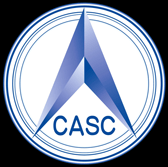
The China Aerospace Science and Technology Corporation (CASC), established in 1999, is state-owned and controls "subsidiaries" that design, develop and manufacture spacecraft, launch vehicles, missile systems, and ground equipment. Along with space and defense manufacture, CASC also produces machinery, chemicals, transportation equipment, electronic technology, medical and environmental protection equipment. This organization also works with China's "commercial" organizations. The entire Chinese space program is intermixed with China's military organizations, so there is not really a separation between these two as there is in the U.S.A. where NASA is a civilian organization. Even so-called commercial entities in China may be military or partially military in nature.
CASC develops satellites and ground support, international space commercial services, space financial investment, software and information services. CASC is the only broadcast and communications satellite operator in China. CASC carries out national scientific and technical programs such as human spaceflight, lunar exploration, Beidou navigation, and Earth observation systems. Its major programs include heavy launch vehicles, Mars exploration, asteroid exploration, and space-ground information network.
China Aerospace Science and Industry Corporation (CASIC)
The China Aerospace Science and Industry Corporation is a state-owned enterprise that focuses on aeronautics and national defense. CASIC is China's largest manufacturer of missiles. It has a system for research, development, and manufacturing of missile systems, solid propellant rockets, space technological products, and other technologies. CASIC plays an important role during natural disasters due to its emergency and rescue capabilities.
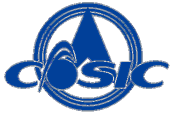
Yuan Wang Tracking and Transportation Ships
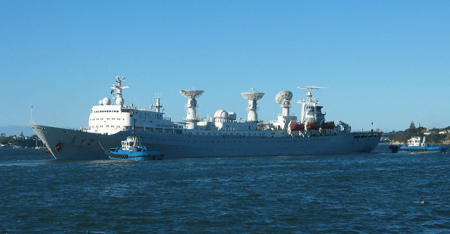
In the 1980's, the Yuan Wang-class tracking ship was developed. Two of these vessels were built in Jiangnan Shipyard in Shanghai and put to sea in 1977 and 1978. This gave China the ability to communicate with their satellites when they were not over Chinese territory. China's communication ships carry three large dish antennae and other communication equipment. Yuan Wang 3 was built in the mid-90's and is still active. Yuan Wang 5 is a new generation of tracking vessel. Like the other communication ships, it was built at Jiangnan Shipyard. Yuan Wang 6 is built like the Yuan Wang 5 and was operating by July 2008. Yuan Wang 6 is 222 meters long and 25 meters wide. Yang Wang 7 was put into service in July 2016.
China also needed a way to transport heavy equipment. The transport ship, Yuan Wang 21 is 130 meters long, 19 meters wide, 12 meters deep, with a draught ~5.8 meters, put to sea on August 31, 1977. A second vessel, Yuan Wang 22, put to sea on September 1, 1978. These vessels transport space hardware and rockets to the Wenchang Space Launch Site. Launch vehicles and space hardware being transported need temperature and humidity control, protection from salt water, and careful handling. Marine environmental protection, vibration reduction methods, temperature controls and humidity for the shipping process was developed.
China Satellite Series
China has five satellite series: Dongfanghong (DFH) - (literally means East is Red) are telecommunications satellites, Fengyun (FY) meteorological satellites, Shijian(SJ) science research and technology experimental satellites, and the Ziyuan (ZY) earth resource satellites. Zhongxing are powerful military communications satellites that utilize the DFH platform. The Zhongxing 19 satellite was launched in November 2022.
Long March Rocket Series
As previously mentioned, the Long March rocket series was originally called Feng-Bo. The first "Long March" or "Chang Zheng-1" rockets were three-stage rockets with the first stage using liquid propellents and the second stage relying on solid rockets. The CZ-1 is no longer used.
Long March-2 (CZ-2)
In the Long March-2 rocket series, the successful versions are:
Long March-2C (CZ-2C)
It is a two-stage launch vehicle with optional configurations. The 2C/SD is a commercial satellite launcher that allows two satellites to launch simultaneously. The 2C/SM version delivers small satellites to high orbits. 2C/SMA is an improved version of the 2C/SM version.
Long March-2D (CZ-2D)
The Long March-2D is unlike other members of the CV-2 class, because it was modified by advancements made during the development of the Long March 4 launch vehicle. The CV-2D is a a two-stage rocket used to launch satellites to low-Earth orbit.
Long March-2E (CZ-2E)
The Long March-2E was a 2-stage launch vehicle with 4 strap-on boosters. The first stage was developed on the basis of LM-2C. This unfortunate rocket was prone to shaking and had compatibility flaws with American-made satellites. Investigation of launch failure with Hughes satellites that was caused by wind shear and fairing flaws gave rise to problems with sharing of US satellite data. The Long March 2E was retired and replaced by the highly successful Long March-3.
Long March-2F (CZ-2F)
It is the CZ-2F version of the Long March-2 that I will be focusing on because this is the rocket that launches humans into space. It was designed to launch the Shenzhou spacecraft, China's human-rated spacecraft. The Shenzhou means "Divine Craft" and is based on the Russian Soyuz design.
This rocket is similar to the Long March 2E. Many of the changes were made to accommodate human spaceflight. Additional redundant systems were added to improve safety and some structural modifications to support the heavier fairing required by the Shenzhou capsule. The rocket is also capable of lifting 8,400 kg (18,500 lbs.) to low Earth orbit and heavier payloads if extra boosters are added to the first stage. Sometimes Long March 2E is referred to as "Shenjian" meaning "Divine Arrow". The Long March 2F first flew on November 19, 1999, with the uncrewed Shenzhou-1 spacecraft. On October 15 2003, a Long March 2F successfully launched Shenzhou-5, carrying Yang Liwei for China's first human spaceflight. (This is discussed in detail below.)
Long March 2F/G was designed to launch the space laboratories such as Tiangong-1 and Tiangong-2. It has no the launch escape system and a larger fairing to accommodate the space station modules.

Long March 3 (CZ-3)
The Long March 3 is a three-stage rocket capable of launching satellites into geosynchronous orbits. The Long March-3 rockets in use today are the CZ-4/BE series. The CZ-4/BE is capable of launching 12,100 pounds (5,500 kg).
Long March 4 (CZ-4)
Long March 4B and 4C are three-stage rockets with a maximum payload of 6,200 lbs. (2,800 kg). designed for launching satellites into polar and sun-synchronous orbits.
Long March 5 (CZ-5)
The Long March-5 can be referred to in a variety of ways with LM-5 being the common English designation. In China it is the Changzheng 5 (CZ-5). It also has a nickname, "Pang-Wu" or "Fat-Five". You may have noticed that these designations for the Long March rockets are being exchanged freely. If there is a picture of a rocket launch CZ-XX will appear in large letters on the side of the vehicle.
China began developing new cryogenic and kerosene-burning rockets in the early 2000's. Long March-5 is a Chinese heavy-lift launch vehicle that uses non-hypergolic liquid propellants. (Hypergolic systems using a combination of propellants that spontaneously ignite when they come into contact with each other.)
The Long March 5B or CZ-5 rocket is used to launch the massive space station modules to low Earth orbit. It also launched the Tianwen-1 mission to Mars. The CZ-5 was developed by the Chinese Academy of Launch Vehicle Technology (CALT) and the Shanghai Academy of Spaceflight Technology (SAST). CZ-5 is a two-stage rocket with an optional upper stage. It has four strap-on boosters with YF-100 (solid rocket fueled) engines on the first stage. The first stage is 5m in diameter and is powered by 2 YF-77 engines. These engines use liquid hydrogen fuel and liquid oxygen oxidizer in a gas generator cycle. These engines can gimbal independently in two planes. The second stage uses two YF-7D5 engines. These engines also use liquid hydrogen and liquid oxygen but they work with a closed expander cycle. They also gimbal to enable thrust vectoring control. The Long March 5B variant has an additional four strap-on liquid-fueled boosters.
The CZ-5 rocket can carry 25,000 kg (55,000 lb) to low Earth orbit and the CZ-B rocket can lift ~14,000 kg (31,000 lb) to geostationary transfer orbit.
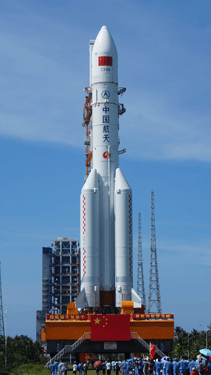
at Wenchang Space Center
It is impossible to discuss the Long March-5B rocket without mentioning that this is the rocket that China uses to launch spacecraft to orbit and beyond. Unfortunately, the first stage of the Long March 5B (CZ-5B), reaches orbital velocity. This spent vehicle weighs 21.6 tons and lacks the capability for controlled atmospheric re-entry. This means that there is a risk that some debris that did not burn up completely can reach the ground and cause damage. Each launch ends the same way, and apparently there is no plan by CNSA and its subordinate entities to modify the rocket to prevent this from happening.
China's First Academy of China Aerospace Science and Technology Corporation is working on another of the Long March-5 variants. The rocket will be taller, 90 meters high. It is expected to weigh ~2,000 tons and be capable of launching a 25-ton payload directly into the lunar orbit. Equipped with 6 strap-on boosters, 3 stages, an escape tower and fairing, the new rocket is called, CZ-5DY, Dengyue or "Lunar Landing". This new generation of crewed launch vehicle must be highly reliable and safe to carry humans into space.
Long March 6 (CZ-6)
The Long March 6 (CZ-6) launched in September 2015. It was designed to be a light lift rocket that is capable of placing at least 1,000 kg (2,200 lb.) into Sun-synchronous orbit. The Long March-6A variant has four strap-on solid boosters, a longer first stage, larger second stage, and can lift at least 4000 kg to Sun-synchronous orbit. The first flight for this variant was on March 29, 2022. It has the distinction of being the first rocket with solid rocket boosters.
Long March 7 (CZ-7)
The Long March 7 is the medium-lift rocket that uses liquid oxygen and kerosene. There is a CZ-7A variant that uses the boosters and the first two stages and adds a third stage that employs two cryogenic YF-75 engines. (These use liquid hydrogen fuel and liquid oxygen oxidizer in a gas generator cycle.)
Long March 8 (CZ-8)
The Long March 8 rocket is based on the Long March 7 architecture using the third stage like the CZ-7A. Having had 2 successful launches, there are plans for a future Long March 8 variant that will be partially reusable. This will be accomplished by recovering of the first stage and the boosters as a single unit.
Long March 9 (CZ-9)
Long March-9 0r CZ-9 is currently under development as a super-heavy carrier rocket. The Long March 9 is expected to have a maximum capacity to launch 150,000 kg to low Earth orbit (LEO), 50,000 kg to trans-lunar injection, and 44,000 kg to Mars.
Long March 11 (CZ-11)
The Long March-11 rocket is a four stage, solid-fueled launch vehicle that can be launched from land and or sea launch. It can be launched quickly and easily even from a road vehicle. It's also a pioneer in the field of commercial spaceflight in the country. This vehicle is currently being built at the Haiyang spaceport, in China's facilities that are still under construction.
In April 2022, the Long March 11 launched off the coast of the East China Sea sending five Jilin-1 Gaofen Earth observation satellites into a polar low-Earth orbit.
#AstrasStargate #ImaRocketFan

China's Aerospace Facilities
Beijing Aerospace Flight Control Center
The Beijing Aerospace Flight Control Center once known as Beijing Aerospace Command and Control Center (BACCC or BACC), is the command center for the Chinese space program.
BACC's primary functions include supervision, telemetry, tracking and command of spacecraft. This includes the crewed Shenzhou missions. The building is inside a complex nicknamed Aerospace City. It was initially created for China's crewed space missions, also known as "Project 921". The BACC uses four Yuan Wang-class tracking ships to communicate and command Shenzhou missions.
Haiyang Oriental Aerospace Port, Shandong Province
The Haiyang Oriental Aerospace Port or "Eastern aerospace port" is under development by CASC as base for sea launches of solid rockets.
Taiyuan Satellite Launch Center, Shanxi Province
Founded in March 1966, the Taiyuan Satellite Launch Center was operational in 1968. Situated in Kelan County of north China's Shanxi Province, Taiyuan is located at an elevation of 1,500 meters. The site began launching international satellites in 1985.
Jiuquan Satellite Launch Center, Gobi Desert
Founded in 1958, the Jiuquan Satellite Launch Center. is also known as Shuangchengzi Missile Test Center, Launch Complex B2, located in the Gobi Desert, Inner Mongolia. It is part of the Dongfeng Aerospace City (Base 10). This site is at 40 deg. latitude and is used to launch crewed Shenzhou spacecraft.
Xichang Satellite Launch Center, Sichuan
The Xichang Satellite Launch Center (XSLC) aka the Xichang Space Center, is located in Zeyuan Town, approximately 64 km or 40 mi. northwest of Xichang, in Sichuan. It became operational in 1984 and is used to launch civil, scientific, and military payloads. The Xichang center has three launch complexes. Launch Complex 3 (LC-3 or LA-3) was demolished and rebuilt twice, the latest upgrade was made in 2015. Located at 28.2 deg. N., this site is often used to launch satellites into geostationary orbits for communications and meteorology. The LA-3 complex is used for the lunar Chang'e program.
Wenchang Space Launch Site, Wenchang, Hainan Island
Wenchang Space Launch Site (or spaceport) is located in Wenchang on Hainan Island off the mainland of China. Originally it was a suborbital test center. It is at a low latitude, only 19° N. of the equator. It is capable of launching the Long March 5, China's most powerful rocket. This is the site where all of China's space station modules are launched. China's other space centers on the mainland use rail tracks to transport large components, they are too narrow to transport the Tiangong space station large modules. Wenchang uses its sea port for deliveries of the giant modules, fabricated in Tianjin, China.
Space Vehicle Landing Sites
Siziwang Banner Landing Site
Dongfeng Landing Site
Both sites are located in China's inner Mongolia region and these are the only sites where space vehicles and human crews can land. The Siziwang Banner landing site is located in Ulanqab and the Dongfeng landing site is in Alxa. Dongfeng is also known as Dongfeng Aerospace city.

China's Reusable Experimental Space Plane
China's "secret" uncrewed space plane, the Chongfu Shiyong Shiyan Hangtian Qi (CSSHQ) was first launched on September 4, 2020 on a Long March 2F from the Jiuquan Satellite Launch Center, in the Gobi Desert. The first mission lasted 2 days, landing on September 6. Very little is known about the spaceplane, but it is believed that the plane lands on a long runway built in 2016 near the the Lop Nur military base in Xinjiang. The runway is 16,400 ft. long, just short of 5 kilometers or over 3 miles long. Making it the second lognest runway in the world.
CSSHQ's second mission began when it was launched on August 4, 2022. (The mission has been identified as CSSHQ-2.) The spaceplane last 276 days in low earth orbit and was observed to have launched a small satellite. It returned to Earth on May 27, landing in the Gobi Desert.
Chinese Deep Space Network (CDSN)
The Chinese Deep Space Network (CDSN) is a network of large antennas and communication facilities that are used for the deep space missions of China. CDSN is managed by the China Satellite Launch and Tracking Control Center (CLTC), and is part of the People's Liberation Army's Strategic Support Force Space Systems Department. In 2008, China began building its Deep Space TT&C Network for tracking and telecommunication support. The Deep Space Mission operation center is located in the Beijing Aerospace Control Center.
CDSN currently includes:
Kashgar monitoring station's Kashi Deep Space Antenna Array in Xinjiang consists of four 35-meter antennas that work in the S, X, Ka bands. This system was used for the Mars Tianwen mission.
A 66-meter antenna in Jia Musi (JMS-66m), working the S and X bands is currently the largest antenna being used. A second 35-meter antenna is planned for this site.
The Miyun Radio Telescope (MRT50) near Beijing is a 50-meter antenna.
Yunnan Astronomical Observatory (YAO) has a 40-meter antenna.
The Espacio Lejano Station, located in Argentina, and operated by CSNA in collaboration with Argentina's National Space Activities Commission (CONAE), has a 35-meter antenna.
In addition to the large antennas, a subnet of 18-meter antennas that work in the S and X bands are located in the Shandong provinces of Kashgar and Qingdao. The subnet also includes the Swakopmund Tracking Station located in Namibia that has an 18-meter antenna

China Manned Space Program (CMS)

The China Manned Space Program (CMS) was established by China in September 1992. The program used a three-step process to make China the third world power to launch humans to space. In summary, the first step was to launch a crewed spaceship and carry out space experiments. In step 2, the program was to develop the ability to carry out Extravehicular Activities (EVA), successfully carry out rendezvous and docking of manned spaceships, and launch a space laboratory. In the third step, CMS established a space station that would be crewed and carry out a long term mission.
CMS is a large organization that has many subordinate organizations and is responsible for China's human spaceflight program. The organization covers the following aspects of China's space exploration activities.
The CMS program is divided into constituants or systems, each responsible for a unique function. The Astronaut System that ensures the health and performance of astronauts during long term space flight. It includes astronaut training, astronaut support and human space life science research. The astronaut program is called, People's Liberation Army Astronaut Corps (PLAAC) and all astronauts are military officers. Male astronauts are fighter pilots and the female astronauts are transport pilots. Astronaut training provides a competent Astronaut (or Taikonaut) Corps and helps to select and train qualified crew for human spaceflight missions. Astronaut support means constructing the life support systems, healthy work and living system, and the work support system. This program ultimately sets the medical and ergonomic requirements for human-rated spacecraft and provides support for astronauts during orbital flight.
The Space Application System is responsible for the development of space science and related applications. In this system the purpose is to make use of the on-board applications that enable space science experiments and investigations, pursue breakthroughs in space science, and other applications.
China's Manned Spacecraft System developed the Shenzhou spacecraft as well as the various Long March (CV) rockets that are incorporated into the CMS program. CMS is also responsible for the launch facilities that support human spaceflight operations. That would be the Jiuquan Satellite Launch Center for human spaceflight and the Wenchang Space Launch Site that launches large components of the space laboratory (station). CMS oversees the landing site system for tracking and locating the capsules that have landed, and rescuing the astronauts if needed. and refurbishing and recycling the re-entry capsules and payloads.
CMS also is concerned with the Telemetry, Tracking, and Command (TT&C) and Communications System that is used to monitor and control the flight path, altitude, and operating status of the rockets and spacecraft used in human spaceflight. CMS also provides channels for video and voice communications with the astronauts and sending scientific data back to Earth.
Another major role that is played by CMS in China's space program is the building of space laboratories, that is the space station modules that have been launched as described. This includes the development and building of China's Tiangong Space Station. The Optical Module that covers the research and development of optical facilities and optical platforms is also part of the CMS program. Lastly CMS is responsible for the cargo resupply vehicle, the Tianzhou spacecraft.

Shenzhou spacecraft
CMS uses the Jiuquan Satellite Launch Center in the Gobi Desert to launch the Shenzhou spacecraft and its human crews. The Shenzhou Spacecraft consists of three sections - - the Orbital Module, Instrumentation Module, and Entry Module between the other two sections.
The Orbital Module contains the crew quarters and life support systems. It also serves as an airlock for spacewalks or EVAs. This module may also be outfitted with a docking system at the forward end of the orbital module.
The Entry Module has a total mass of 3,240 Kilograms and offers 6 square meters of habitable volume. The Entry module houses vehicle control systems and crew seats. The crew is isolated in the Entry Module for launch and landing.
The Entry module has three custom-made seat-liners for the crew. Crew members wear Launch and Entry Suits. The Entry Module contains the Central Terminal Unit – the triple redundant and flight computer of the Shenzhou Spacecraft that controls all aspects of the flight. This includes – ascent, orbital flight, and re-entry as well as the landing process. The entry module’s emergency data recorder is built to withstand 10,000 G’s and a temperature of 1,200°C.
The Instrumentation or Service Module (SM) is located underneath the other two modules and contains the equipment and avionics necessary to support the vehicle during its mission. The SM provides electrical power, attitude control, and propulsion for the spacecraft in orbit. The module features two solar arrays that are deployed after orbital insertion and batteries that are the electrical system of the spacecraft. The batteries can provide emergency power to the vehicle for up to six hours.

CNSA's first crewed mission was carried out in 2003 when Yang Liwei flew aboard Shenzhou 5 mission. The Shenzhou spacecraft was launched on a Long March 2F rocket from Jiuquan Satellite Launch Center.

Yang Liwei was born June 21, 1965. He is a major general in the People's Liberation Army Astronaut Corps (PLAAC). He was a military pilot who became an astronaut or taikonaut. Yang completed 14 orbits and was in space for a total of 21 hours. Yang made a hard landing in the grasslands of Inner Mongolia on October 16, 2003.
Step 2 was met when taikonauts, Zhai Zhigang, Liu Boming and Jing Haipeng were launched on Shenzhou 7 on September 25, 2008, by the Long March 2F rocket from Jiuquan Launch Center. Two taikonauts carried out simple tasks while outside the spacecraft. Zhai Zhigang used an EVA space suit made in China and Liu Boming used an EVA space suit imported from Russia. Next the Tiangong I spacecraft was launched from Jiuquan on a Long March 2F/G rocket. It was to be used to carry out the rendezvous and docking tests needed to complete step 2. On November 3, 2011, the first successful docking was carried out autonomously by an uncrewed Shenzhou 8.
The next mission Shenzhou 9 sent China's first woman taikonaut, Liu Yang, who was launched with Jing Haipeng and Liu Wang from Jaiquan on June 16, 2012. the crew docked the Shenzhou craft to the Tiangong-1 station. the crew was able to enter the station successfully, and thus began CNSA space station adventures. The crew left the ship and undocked on June 24, only to return a while later exercising their rendezvous skills. On June 28, Shenzhou 9 undocked and returned to Earth.
Liu Yang was born October 6, 1978. Major Liu Yang served in the Wuhan Flight Unit in China's Air Force when she was selected for the astronaut program. On June 16 2012, Liu became the first Chinese woman in space. She was the 56th woman to fly as an astronaut. Interestingly, in order to become an taikonaut in China, a woman must be married. During the Shenzhou 9 mission, Liu performed experiments in space medicine.


Palace in the Sky
The Tiangong Space Station Program
Jump to CSS modules: Tianhe > Wentian > Mengtian > Xuntian telescope > Tianzhou Resupply
Tiangong-3, is a space station that was constructed by China in low-Earth orbit between 340 - 450 km (210-280 mi.) above the surface. Its orbital inclination is 42.8 degrees and its orbital speed is 7.68 km/s or 4.77 mi/s. China's latest space station is expected to have a 10-year life span, meeting the final goal CMS's 3-step program. As completed, Tiangong has a mass between 80 and 100 t. (180,000 and 220,000 lbs.), about one-fifth the mass of the International Space Station.
CNSA's space station, Tiangong, or "Heavenly Palace" consists of three components, with the capability for future expansion. Is is also referred to as the China Space Station or simply "CSS". There is a core module, Tianhe, and two space laboratories, or Laboratory Cabin Modules (LCM). After the launch of the second component, the Wentian module, on July 24, 2022, 3 additional berths were added so that the station can support a 6-person crew. The third component Mengtian module was launched on October 31, 2022 completing the Tiangong space station.

China Space Station - Tiangong
The core module called, "Tianhe" or "Harmony of the Heavens" core module, was launched on April 29, 2021. The construction of the Tiangong space station is based on the experience gained from its precursors, Tiangong-1 and Tiangong-2. Conducting mircrogravity research on the station will continue to improve with the new space station. There are 4 Hall Effect Thrusters for orbital control and in fact, Tianhe is the first human-rated vessel to use them.
Tianhe Core Module (TCM)
This module is cylindrical, with a diameter of 4.2 m or 14 ft. The module is 16.6 m or 54 ft. long. Its on-orbit mass is 22,600 kg (49,800 lbs.). The module has living quarters for three crew members. The module also provides the station's power, propulsion, and life support system, guidance, navigation, and orientation control for the station. It consists of three sections: the living quarters, the service section (no life support), and a docking hub.

On the left side of the figure above, the front of the Tianhe module is the multi-docking node. It contains 4 ports for docking and attaching of other modules. The Wentian and the Mengtian nodes will be attached to the station on this node. On the top of the node is a hatchway where crew can exit the station and perform spacewalks. The small cylindrical section is the crew quarters. At the end of the module is the port for the cargo ship Tianzhou to attach and deliver supplies. The Tianhe module has two sets of 12.6-meter solar arrays.
The Tianhe module also has a robotic arm. The arm measures about 10 m or 32 ft. The arm can disengage from its primary base and crawl along the surface of the space station and dock with one of the other adapters located on the station. This is similar to how the CanadArm can move along the International Space Station. One of its functions is to help cargo ships dock at the space station. The Wentian module also has a robotic arm that measures about 5 m or 16 ft. in length that can attach to the primary arm to create an arm about the size of the CanadArm. The larger size, plus the mobility of the arm means that it will have access to the entire outside of the CSS.
The first crew arrived on the Shenzhou-12 spacecraft, successfully boarding on June 17, 2021. Taikonauts Nie Haisheng, Liu Boming and Tang Hongboof of the People's Liberation Army Astronaut Corps (PLAAC) made up the crew. The taikonauts made 2 spacewalks totaling ~12.5 hours to conduct extra-vehicular activities and additional testing of their spacesuits. The crew returned on September 17, 2021.
The next crew arrived on the Shenzhou-13 spacecraft, successfully boarding on October 17, 2021. Mission commander Nie Haisheng was accompanied by taikonauts, Liu Boming, and Tang Hongbo also from the PLAAC. The crew returned to Earth on April 16, 2022. The mission lasted 92 days, and two spacewalks were made to aid the construction of the station. The next crew to arrive docked with the Shenzhou 13 spacecraft. The mission included Ye Guangfu, Zhai Zhigang, and Wang Yaping (the second female taikonaut). This mission lasted 180 days and included two spacewalks. After the mission, Wang had spent about 197 days in space, a new record for a Chinese astronaut.
The Shenzhou 14 spacecraft brought three astronauts to begin a six-month mission. Mission commander Chen Dong, female astronaut Liu Yang, and Cai Xuzhe arrived at Tianhe station on June 4, 2022. These astronauts will assist with arrival of the two new 20-ton research modules. They will unpack equipment and supplies delivered by the Tianzhou 4 cargo vessel that has been docked at the station since May 10, 2022.
The fourth crew launched from Jiuquan on a Long March 2F rocket on November 29, 2022 in the Shenzhou-15 spacecraft. The three PLAAC taikonauts arrived at the Tianhe station were commander Fei Junlong, returning to space for the second time, Deng Qingming and Zhang Luon who were on their first space mission. Fei Junlong and Zhang Lu performed four spacewalks while Zhang Luon assisted from inside the module. The crew is scheduled to return to Earth on June 3, 2023.
The fifth crew launched from Jiuquan on a Long March 2F rocket on May 30, 2023 in the Shenzhou-16 spacecraft. Three taikonauts arrived at the Tianhe station including commander Jing Haipeng, PLAAC, on his fourth space mission. Zhu Yangzhu and Gui Haichao are on their first space mission. Gui Haichao is a professor at Beihang University, on this mission became the first Chinese civilian in space.Fei Junlong and Zhang Lu performed four spacewalks while Zhang Luon assisted from inside the module. The crew returned to Earth on October 30, 2023.
The sixth crew launched from Jiuquan on a Long March 2F rocket on October 26, 2023 in the Shenzhou-17 spacecraft. Three taikonauts arrived at the Tianhe station, all being PLAAC members. Mission commander Tang Hongbo, flew on the Shenzhou 12 space mission. He was the first taikonaut to return to the space station. When Tang Shengjie flew he became the youngest taikonaut on the station. The third taikonaut on this mission was Jiang Xinlin. The crew performed two space walks and returned to Earth on April 30 2024.
The seventh crew launched from Jiuquan on a Long March 2F rocket on April 25, 2024 in the Shenzhou-18 spacecraft. Mission commander Ye Guangfu, is on his second mission to the spacestation. Li Cong and Li Guangsu are on their first space mission. The crew is planned to return to Earth in October 2024.
Wentian module
Tiangong's Wentian Laboratory Cabin Module was launched July 24, 2022. The Wentian module functions as backup for the Tianhe's navigation and orientation capabilities. Small propulsion nozzles are located in the silver area near the docking ring and several at the opposite end of the module as well as some near the external experiment rack.
Wentian provides a pressurized environment for researchers to conduct microgravity science. Experiments can also be placed on the outside of the module, allowing exposure to the space environment. Although Wentian supplies 3 slots for taikonauts to sleep, they are intended for use during the changing of crew when six crew members may be on the station. In addition, the antennae on the Wentian will complement the Tianhe's antenna, enabling constant communication with the relay satellite. Wentian also provides an additional airlock for taikonauts to perform EVA activities. It will be the main airlock for taikonauts to exit and enter the station.
Wentian also supplies 330-meter, third-generation flexible gallium arsenide solar arrays. They are advanced solar arrays that have a collecting area equivalent to 80-square meters and can provide 20 KW power to the core module. The thickness of a solar panel is less than one millimeter. The design life of the solar panels is up to 15 years and they can be repeatedly folded and unfolded if necessary. These solar arrays will become the main source of power for the CSS. When the Wentian and Mengtian are in place, the smaller arrays of the Tianhe will be in shadow, so the plan is to move them to the outside ends of the experimental laboratories using the robot arm.
The 5-meter arm on the Wentian module will also be used to place experiments on the external experiment racks located in the middle of the module. The arm is capable of lifting 5 tons. The external experiment racks can hold up to 24 experiments. This can provide exposure to the vacuum of space, solar radiation, or extreme temperatures. The payload racks can provide power, temperature control, or data transmissions. The Wentian module is also full of racks for experiments.
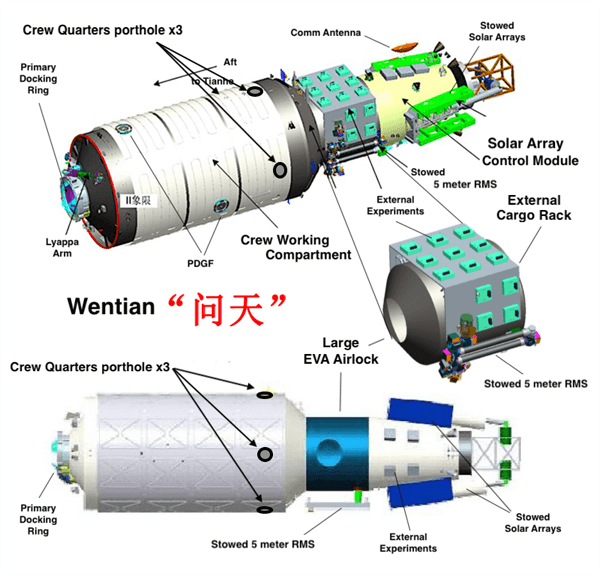
Mengtian module
The Mengtian Laboratory Cabin Module was launched on October 31, 2022. Mengtian means "Dreaming of Heaven". Unlike the Wentian module, it has no sleeping quarters. Mengtian has its own 5 m (16 ft.) robotic arm that has better accuracy than the main arm on Tianhe. Mengtian has two steerable solar power arrays that use photovoltaic cells to convert sunlight into electricity. It also has propulsion engines to help the CSS counter the effects of atmospheric drag. Mengtian will have an atomic clock system to add in gravitational redshift research and other applications.

Xuntian module
China is also developing a space telescope with a 2-meter or 6.6-foot diameter mirror. It will be in orbit close to the Tianzhou space station and will be able to dock for repairs, maintenance, and upgrades. The Xuntian Space Telescope is planned for launch in 2024.
Xuntian Space Telescope (XST)
The name of the telescope, Xuntian, means to "survey the heavens,". The telescope 10-year primary mission will be to survey 40% of the sky. This telescope may also be referred to as Chinese Space Station Telescope (CSST). It has a three-mirror anastigmat system that also uses a Cook-type off-axis telescope design to eliminate any central obstruction. The anastigmat design corrects for spherical aberrations, coma, and astigmatism.

The Xuntian will be about the size of a bus and weigh more than 10 tons, according to China's state media outlet, CGTN. A prototype of the telescope is being developed at the Changchun Institute of Optics, Fine Mechanics and Physics. The Xuntian Space Telescope will be made up of five modules (instruments):
Survey Camera (SC)
Is the telescopes main instrument. It has a high-resolution 2.5-billion-pixel camera with a wide field of view (FOV) that is 1.1-square degrees! It will be able to survey roughly 40 percent of the sky over its 10-year primary mission.
Terahertz Receiver (THz)
Detect high frequencies radiation from 0.3 to 3 terahertz that is between the microwave and the infrared region of the electromagnetic spectrum.
Multichannel Imager (MCI)
To provide redshift measurements it has nine 9 filters covering the near-ultraviolet to near-infrared spectrum.
Integral Field Spectrograph (IFS)
Working in the near-infrared range this instrument can study super-massive black holes and star formation in galaxies.
Cool-Planet Imaging Coronagraph (CPIC)
CPIC will be used for extrasolar planet imaging.
Previous telescopes launched by China include the Hard X-ray Modulation Telescope (HXMT), launched in 2017. It is also referred to as Insight-HXMT. The satellite includes three telescopes working at X-ray ranges 20–250 keV, 5–30 keV, and 1–15 keV. The telescope is still in operation as of this writing.
The Dark Matter Particle Explorer (DAMPE) is also called Wukong. It launched in December 2015 on a Long March 2D rocket from Jiuquan Satellite Launch Center. It is China's first space observatory. DAMPE is a space telescope used to detect high energy gamma rays, electrons and cosmic ray ions, to aid in the search for dark matter. The telescope was led by Chinese Academy of Sciences (CAS) and Purple Mountain Observatory (PMO) in collaboration with other research institutions and universities in China, Italy, and Switzerland.

Here is a great video by The Space Race, it is an 16-min overview of Chinas's Tiangong-3 orbiting space station. Very well done!
Tianzhou Cargo Resupply Vessel
CNSA also developed the Tianzhou automated cargo spacecraft. Tianzhou 1 launched on the Long March 7 rocket from Wenchang on April 20, 2017. It has been used for resupply and to equip the Tianhe core module. It has made three trips to the Tianhe and the last mission as of this writing was Tianzhou 5 that was launched on November 12, 2022.
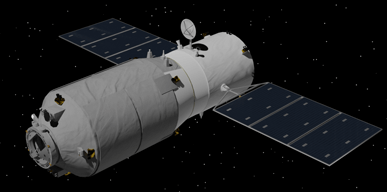
Tianzhou has a launch mass up to 13,500 kg or 29,800 lbs. and can carry 6,500 kg or 14,300 lbs. of cargo.

Tiangong-2, Space Laboratory
Tiangong-2 was successfully launched from Jiuquan Satellite Launch Center on September 15, 2016. Tiangong-2 was not a permanent orbital station. It was to function as a test bed for key technologies for building a more permanent station. It was similar in appearance to the Tianhe core module above, however it lacked a docking node.
The Shenzhou-11 spacecraft arrived on October 19, 2016 with astronauts Jing Haipeng and Chen Dong aboard. During the mission, more than 60 scientific experiments and tests were conducted, including medical and on-orbit maintenance tests giving China valuable experience. The astronauts stayed for about 30 days, undocking on November 17, 2016, and returning to Earth. Tiangong-2 was de-orbited as planned on July 19, 2019. In April 2017, the cargo spacecraft Tianzhou-1 autonomously docked, demonstrating the ability to transport cargo and on-orbit propellant refueling.
Tiangong-1
Tiangong-1 was China's first prototype space station. It orbited Earth from September 2011 to April 2018, serving as both a crewed laboratory and an experimental test bed to demonstrate orbital rendezvous and docking capabilities. It also built on China's experience for the construction, management, and operation of space stations.
Tiangong-1 operated for two years and was visited by Shenzhou spacecraft. The uncrewed Shenzhou 8, successfully docked with the module in November 2011. The Shenzhou 9 crewed mission docked in June 2012. A third and final mission to Tiangong-1, the crewed Shenzhou 10, docked in June 2013. The crewed missions to Tiangong-1 were notable for including China's first female astronauts, Liu Yang and Wang Yaping.

China's Lunar Exploration Program
China's lunar exploration program is centered on the Chang'e Project named after the Chinese moon goddess Chang'e. The program has included orbiters and landers, but these are only a precursor to China's plans to develop a lunar colony near the southern pole of the Moon.
Chang'e 1
It entered lunar orbit on November 5, 2007, and returned the first picture of the Moon on November 26, 2007. The spacecraft mapped the entire lunar surface. Although the primary mission lasted one year, it operated until March 1, 2009, when it was intentionally impacted on the surface of the Moon.
Chang'e 2
Chang'e-2 launched to the moon on October 1, 2010. The spacecraft was to help identify locations for a lander for China. Chang'e-2 left lunar orbit and flew to the L2 Lagrange point, where the gravitational pull of the Earth and Sun is equal. Here they tested deep-space communications and tracking for future missions. In April 2012, the spacecraft moved off to fly by the asteroid 4179 Toutatis in January 2013.

Chang'e 3
Launched on December 1, 2013, Chang'e 3 soft landed on the lunar surface on December 15. It was a lander and a rover named "Yutu" or "Jade Rabbit". Yutu rover traveled 114 meters (374 feet) on the lunar surface but was unable to travel further after January 2014. It transmitted data from its stationary position until March 2015.
Lunar-based ultraviolet telescope (LUT)
Chang'e 3 lander also carried a 150 mm (~6 in.) Ritchey–Chrétien telescope that can be used to observe stars and galaxies in the near-UV band (245–340 nm), and can detect objects down to 13 mag. The Moon's thin exosphere and slow rotation allows for uninterrupted observations of a target. Its major constraint is that it must be used when the Sun is over the horizon so special filters are needed. This telescope is still in operation on the lunar surface.
Chang'e 4
Chang'e-4 was launched on December 7, 2018, Chang'e-4's lander, Jade Rabbit-2 and rover, Yutu-2 is still operating on the Moon. The solar-powered probe goes dormant (~2 weeks) during the lunar night. The lander's equipment includes cameras, a low frequency spectrometer, and a Lunar Micro Ecosystem that worked 9 days instead of the planned 100 days. The lunar rover's equipment includes a panoramic camera, on a mast that can rotate 360°, Lunar penetrating radar and a Visible and Near-Infrared Imaging Spectrometer. Yutu-2 is currently exploring Von Kármán crater in the Aitken Basin near the Moon's south pole.
Chang'e 5
Chang'e 5 launched on November 23, 2020 from Wenchang Space Launch Site. It landed on the Moon on December 1, 2020, collecting ~61 oz. or ~1,731 g of lunar samples. Samples were returned to Earth on December 16, 2020, landing in the grasslands of Siziwang Banner landing site in Mongolia. Chang'e-5 was the first lunar sample-return mission since 1976.
- - Find out about the Chang'e 5 mission at Astra's
Chang'e 6
Chang'e 6 launched on May 3, 2024, from Wenchang Space Launch Site.
- - Find out about the Chang'e 6 mission at Astra's
International Lunar Research Station (ILRS)
The International Lunar Research Station (ILRS) is a lunar base currently being developed by the China National Space Administration and Roscosmos. ILRS will be built on the lunar surface or in lunar orbit that can be used to carry out scientific research, lunar exploration, resource utilization, lunar-based observation, and similar activities. The project will be "open to all interested countries and international partners". Stated timeline for the establishment of a lunar base is 2028.
China published the International Lunar Research Station (ILRS) Guide for Partnership. This link might go to the document, but the latest version should probably be used.
Find out about Chang'e missions to the Moon on Astra's Guide to Lunar Exploration page.
Asteroid Missions
ZhengHe Asteroid Sample Return
China is developing ZhengHe, also known as Tianwen-2, a planned Chinese asteroid sample return mission combined with a comet exploration mission. ZhengHe will use solar electric propulsion to explore the near Earth asteroid 469219 Kamoʻoalewa and the periodic comet 311P/PANSTARRS. It has a very short period of ~3.2 years. It is considered to be a "main-belt" comet.
China has also announced that it plans to build an asteroid database and an asteroid deflection mission. China's first asteroid deflection test is planned for 2025 or 2026.
Mars
Tianwen-1 (TW-1)
China's Tianwen-1 mission's name means, Heavenly Questions. Launched from the Wenchang Spacecraft Launch Site in July 2020 on a Long March 5 rocket. Tianwen entered Martian orbit on February 10, 2021. The mission included the orbiter, a lander, the Zhurong rover, and three additional cameras. The mission's objectives include investigating Mars' surface geology and internal structure, search for indications of water, and characterizing the space environment and the atmosphere of Mars. On May 14, 2021, the lander successfully touched down at Utopia Planitia on Mars, making China the third nation to make a soft landing on Mars. The rover, named Zhurong, was successfully deployed on May 22, 2021. China was the first nation to successfully carry out an orbiting, landing and roving mission at Mars on its first attempt. Both orbiter and rover are still exploring Mars.
- - Find out about the Tianwen-1 mission at Astra's.
China is developing a Mars sample return mission, Tianwen-3. The mission would include a lander and an ascent vehicle that would launch on a Long March 5 in 2028, as well as an orbiter and return module to be launched separately on a Long March 3B. This timeline would mean the samples could be returned to Earth in July 2031.
Jupiter
China is planning a mission to Jupiter with the proposed name of Gan De. There are currently two different plans, the Jupiter Callisto Orbiter (JCO) and the Jupiter System Observer(JSO) have been discussed. In the JCO mission a spacecraft would enter a polar orbit about Callisto and may include a Callisto lander. That mission might end by sending the probe to the Sun-Jupiter L1 point at the conclusion of its primary mission. The intended timeline would see the mission to Jupiter launched by 2029.

Links for China in Space
Information on China's space program is a bit hard to find in the U.S. Because of this, Astra's Stargate has prepared this article. Yes, the information is there but most American citizens remain ignorant of the space exploration activities in China. (Many are not very informed about NASA's space program either.) There are a number of space news sites out there that can keep you informed on what is happening in space and going to them for information will be productive. Anyway, I hope these links can be of help when trying to discover what China has been doing in space.
China Manned Space Program (CMS) - managing human space flight
China Aerospace Science and Technology Corporation (CASC) - these are the folks that build everything
China Aerospace Science and Industry Corporation - this organization is more focused on military.
Chinese Space Program - Everyday Astronaut's web page on China's space program and covers many of the launches.
Dongfang Hour - Web site
Dongfang Hour - YouTube Channel
"Dongfang Hour is a part-time project by Blaine Curcio and Jean Deville, a consultant/entrepreneur and an aerospace engineer. We're both space enthusiasts and familiar with Chinese culture and the Chinese business ecosystem (with a combined 20 years spent in the country!)"
- - about Dongfang YouTube channel
Xinhuanet - China News network
